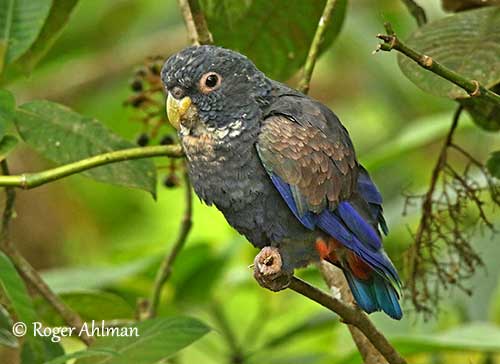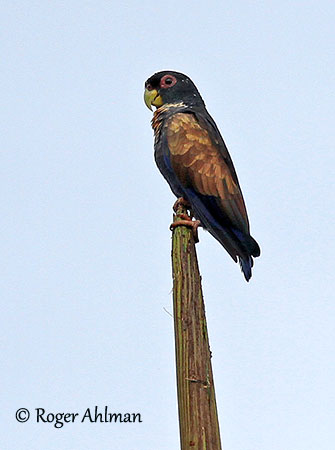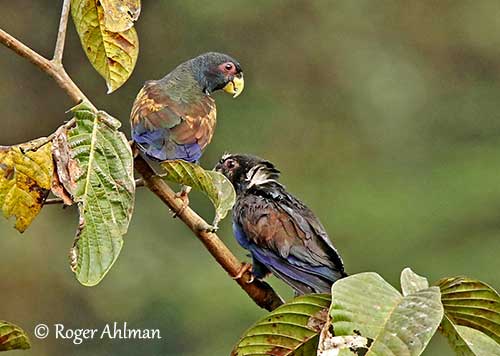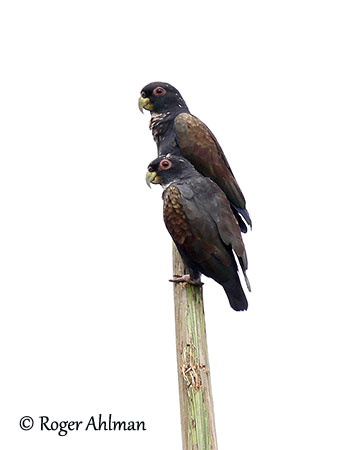
Fr: Pione noire
Ang: Bronze-winged Parrot
All: Glanzflügelpapagei
Esp: Loro Alibronceado
Ita: Pappagallo alibronzo
Nd: Bronsvleugelmargrietje
Sd: bronsvingad papegoja
Photographer:
Roger Ahlman
Pbase Galleries Peru and Ecuador
Text by Nicole Bouglouan
Sources:
HANDBOOK OF THE BIRDS OF THE WORLD vol 4 by Josep del Hoyo-Andrew Elliott-Jordi Sargatal - Lynx Edicions - ISBN: 8487334229
PARROTS OF THE WORLD – An Identification Guide – by Joseph M. Forshaw – Princeton University Press – ISBN 0691092516
Parrots: A Guide to Parrots of the World Par Mike Parr, Tony Juniper – Editeur: A& C Black, 2010 – ISBN: 1408135752, 9781408135754 - 584 pages
The Cornell Lab of Ornithology - Birds of the World
THE AVIANWEB - Beauty of Birds (Sibylle Faye)
Pionus Parrots Research Foundation
Wikipedia, the free encyclopaedia
Bronze-winged Parrot
Pionus chalcopterus
Psittaciformes Order – Psittacidae Family
INTRODUCTION:
The Bronze-winged Parrot is found in the Andes of NW South America where it frequents mountain forests and woodlands. It feeds mainly on various fruits and small seeds.
It is nomadic and locally seasonally migratory, especially in Colombia. It typically nests in tree holes like most members of the order Psittaciformes. Outside this period, it can be seen in groups of up to 15 individuals.
The Bronze-winged Parrot is affected by habitat loss through extensive forest clearance. This species is not a main target of trappers, although illegal trade still occurs in Peru.
But currently, the species is not globally threatened.
DESCRIPTION OF THE BIRD:
Biometrics:
Length: 29 cm
Weight: 200-210 g
The Bronze-winged Parrot has bronze-green upper back, mantle and scapulars, whereas lower back and rump are deep blue. On the upperwing, tertials and wing-coverts are bronze-brown and the flight-feathers are blue. The tail is dark blue.
On the underparts, the chin is white. On the foreneck, the feathers are edged pale pinkish, forming a variable band or a scaly bib. The underparts are deep blue. The undertail-coverts are red and the underside of the rectrices is paler blue. On the underwing, the coverts are dark blue and the flight feathers are paler blue with darker tips.

Head and neck are bronze-brown with dark violet-blue tips to feathers.
The hooked bill is yellow. The eyes are dark brown, surrounded by a bare, pinkish eyering. Legs and feet are greyish-brown.
Male and female are similar. Seen from a distance, the adults have overall dark appearance.
The juvenile has greenish head and upperparts. The underparts are brown with blue wash. The feathers have dark green edges. On the upperwing, the brown coverts have paler tips and green edges. The bare eyering is yellowish-white.
RANGE:
The Bronze-winged Parrot is native to upland and montane forests of NW Venezuela, W Colombia, Ecuador and NW Peru (Tumbes and Piura).
HABITAT:
The Bronze-winged Parrot frequents montane forest and forest edges, but it can be found in drier deciduous woodland too. It usually prefers the canopy of forest and woodland, but it also frequents adjacent habitats with tall trees.
The species persists in secondary growth and farmland with scattered trees or wooded patches.
It is visible between 1,400 and 2,400 metres of elevation, usually as low as 120 metres in northern regions, and up to 2,800 metres elsewhere.

CALLS AND SONGS: SOUNDS BY XENO-CANTO
The Bronze-winged Parrot gives a harsh, screeching “chee-ee…chee-ee…chi-ri-ree” when in flight.
When perched, it utters a wide variety of calls of similar tone.
BEHAVIOUR IN THE WILD:
The diet of the Bronze-winged Parrot is poorly known, but from some observations, the species feeds on various fruit species such as Guazuma ulmifolia (Malvaceae family), bananas and Ficus fruits. It also consumes small seeds.
Local farmers also report that this species feeds on pico-pico fruit, oak leaves and aguatilla (Lauraceae species), guava machetona and guava silvestre fruits (Inga species of family Fabaceae).
An observation describes some feeding behaviour. The parrots were observed in flock, perched quietly in tree in early afternoon. They took off as one and descended from the tree. Each bird leaped from branch to branch while eating and gnawing in the fork of the branches. The bout lasted for 20 minutes. There was no bird standing sentinel while the flock was feeding.
The parrots increase dramatically their levels of food as the breeding season approaches. At this period, the birds need proteins both prior to and during chick-feeding.

Like almost all Psittaciformes, the Bronze-winged Parrot nests in tree hole.
During the breeding season, they are often seen singly or in pairs, but also in small groups of up to ten birds.
The Bronze-winged Parrot is nomadic in Colombia, with some Andean populations disappearing for large portions of the year, probably related to food resources.
The Bronze-winged Parrot performs daily long-distance flights to and from the feeding areas.
The flight is high and swift. The birds are very noisy and conspicuous while flying.
REPRODUCTION OF THIS SPECIES:
The breeding season takes place between March and May in Colombia.
The Bronze-winged Parrot nests in tree hole, usually dead tree cavity.
The female lays 2-5 white eggs and incubates during 24-26 days. The young leave the nest 60-70 days after hatching.
PROTECTION / THREATS / STATUS:
The Bronze-winged Parrot is described as uncommon. The species is fairly scarce in captivity, although illegal trade continues in Peru. It is also persecuted as an agricultural pest.
However, habitat destruction due to forest clearance in Colombia and W Ecuador remains an important threat. In addition, rapid deforestation for cultivation and livestock farming in Venezuela makes the species scarce and local.
The size of the population is unknown, but in spite of the problems described above, the species is not globally threatened, and the Bronze-winged Parrot is currently evaluated as Least Concern.
